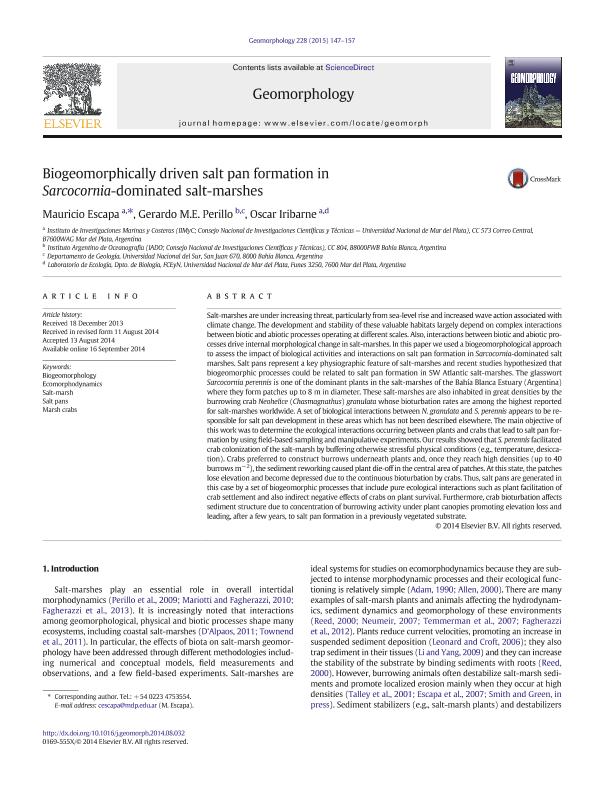Mostrar el registro sencillo del ítem
dc.contributor.author
Escapa, Carlos Mauricio

dc.contributor.author
Perillo, Gerardo Miguel E.

dc.contributor.author
Iribarne, Oscar Osvaldo

dc.date.available
2017-02-03T20:41:08Z
dc.date.issued
2015-01
dc.identifier.citation
Escapa, Carlos Mauricio; Perillo, Gerardo Miguel E.; Iribarne, Oscar Osvaldo; Biogeomorphically driven salt pan formation in Sarcocornia-dominated salt-marshes; Elsevier Science; Geomorphology; 228; 1-2015; 147-157
dc.identifier.issn
0169-555X
dc.identifier.uri
http://hdl.handle.net/11336/12508
dc.description.abstract
Salt-marshes are under increasing threat, particularly from sea-level rise and increased wave action associated with climate change. The development and stability of these valuable habitats largely depend on complex interactions between biotic and abiotic processes operating at different scales. Also, interactions between biotic and abiotic processes drive internal morphological change in salt-marshes. In this paper we used a biogeomorphological approach to assess the impact of biological activities and interactions on salt pan formation in Sarcocornia-dominated salt marshes. Salt pans represent a key physiographic feature of salt-marshes and recent studies hypothesized that biogeomorphic processes could be related to salt pan formation in SW Atlantic salt-marshes. The glasswort Sarcocornia perennis is one of the dominant plants in the salt-marshes of the Bahía Blanca Estuary (Argentina) where they form patches up to 8 m in diameter. These salt-marshes are also inhabited in great densities by the burrowing crab Neohelice (Chasmagnathus) granulata whose bioturbation rates are among the highest reported for salt-marshes worldwide. A set of biological interactions between N. granulata and S. perennis appears to be responsible for salt pan development in these areas which has not been described elsewhere. The main objective of this work was to determine the ecological interactions occurring between plants and crabs that lead to salt pan formation by using field-based sampling and manipulative experiments. Our results showed that S. perennis facilitated crab colonization of the salt-marsh by buffering otherwise stressful physical conditions (e.g., temperature, desiccation). Crabs preferred to construct burrows underneath plants and, once they reach high densities (up to 40 burrows m− 2), the sediment reworking caused plant die-off in the central area of patches. At this state, the patches lose elevation and become depressed due to the continuous bioturbation by crabs. Thus, salt pans are generated in this case by a set of biogeomorphic processes that include pure ecological interactions such as plant facilitation of crab settlement and also indirect negative effects of crabs on plant survival. Furthermore, crab bioturbation affects sediment structure due to concentration of burrowing activity under plant canopies promoting elevation loss and leading, after a few years, to salt pan formation in a previously vegetated substrate.
dc.format
application/pdf
dc.language.iso
eng
dc.publisher
Elsevier Science

dc.rights
info:eu-repo/semantics/openAccess
dc.rights.uri
https://creativecommons.org/licenses/by-nc-nd/2.5/ar/
dc.subject
Biogeomorphology
dc.subject
Ecomorphodynamics
dc.subject
Salt-Marsh
dc.subject
Salt Pans
dc.subject
Marsh Crabs
dc.subject.classification
Ecología

dc.subject.classification
Ciencias Biológicas

dc.subject.classification
CIENCIAS NATURALES Y EXACTAS

dc.title
Biogeomorphically driven salt pan formation in Sarcocornia-dominated salt-marshes
dc.type
info:eu-repo/semantics/article
dc.type
info:ar-repo/semantics/artículo
dc.type
info:eu-repo/semantics/publishedVersion
dc.date.updated
2017-02-03T17:53:07Z
dc.journal.volume
228
dc.journal.pagination
147-157
dc.journal.pais
Países Bajos

dc.journal.ciudad
Ámsterdam
dc.description.fil
Fil: Escapa, Carlos Mauricio. Consejo Nacional de Investigaciones Científicas y Técnicas. Centro Científico Tecnológico Mar del Plata. Instituto de Investigaciones Marinas y Costeras; Argentina. Universidad Nacional de Mar del Plata; Argentina
dc.description.fil
Fil: Perillo, Gerardo Miguel E.. Consejo Nacional de Investigaciones Científicas y Técnicas. Centro Científico Tecnológico Bahía Blanca. Instituto Argentino de Oceanografía (i); Argentina. Universidad Nacional del Sur. Departamento de Geología; Argentina
dc.description.fil
Fil: Iribarne, Oscar Osvaldo. Universidad Nacional de Mar del Plata. Facultad de Cs.exactas y Naturales. Departamento de Biologia. Laboratorio de Ecologia; Argentina. Consejo Nacional de Investigaciones Científicas y Técnicas. Centro Científico Tecnológico Mar del Plata. Instituto de Investigaciones Marinas y Costeras; Argentina. Universidad Nacional de Mar del Plata; Argentina
dc.journal.title
Geomorphology

dc.relation.alternativeid
info:eu-repo/semantics/altIdentifier/url/http://www.sciencedirect.com/science/article/pii/S0169555X14004619
dc.relation.alternativeid
info:eu-repo/semantics/altIdentifier/doi/http://dx.doi.org/10.1016/j.geomorph.2014.08.032
Archivos asociados
